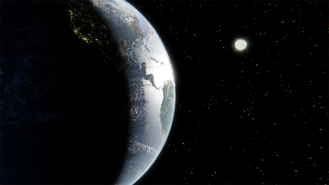A group of MIT researchers is exploring a radical idea for reversing global warming: using a raft of “space bubbles” to reflect sunlight away from our planet.
Hot in here: The copious amounts of greenhouse gasses humans have been releasing into the air ever since the Industrial Revolution are forming a sort of blanket around our planet, trapping heat in the atmosphere and causing global temperatures to creep ever higher.
Most scientists agree that we need to dramatically reduce our emissions to minimize the most severe consequences of climate change, such as rising sea levels, severe droughts, and an increase in extreme weather events.
Solar geoengineering: Unfortunately, it doesn’t look like the world is ready to give up fossil fuels yet, so some researchers are exploring a radical Plan B for reversing global warming: solar geoengineering.
The idea behind solar geoengineering is that we can cool the Earth by reflecting some solar radiation away from it. While there are a few different ways we might do this, the most widely studied technique would involve injecting reflective aerosol particles into the upper atmosphere.
Once those aerosols were released, though, we wouldn’t have a straightforward way to recapture them if the plan didn’t work or had unforeseen negative consequences.
“Even our understanding of the climate change that we’re causing unintentionally right now still has limitations, especially when it comes to impacts further into the future,” Linda Schneider, an international climate policy expert, told Discover Magazine.
“Our understanding of what would happen if we were to intentionally manipulate the climate at a global scale is even less,” she continued.
Bubble block: Instead of injecting particles into Earth’s atmosphere to cool the planet, an interdisciplinary team of MIT researchers proposes we take solar geoengineering to space.
Specifically, the group is investigating what might happen if we positioned a shield made of bubbles at Lagrangian Point 1 — a point in space where the gravitational pulls of the Earth and the sun form a sort of equilibrium that would keep the shield in orbit there indefinitely.
“Most geoengineering proposals are earth-bound … Space-based solutions would be safer.”
Carlo Ratti
The proposed shield would be about the size of Brazil, and the bubbles for it could be manufactured and deployed in space, possibly out of silicon — the group has already experimented with creating these “space bubbles” in the lab.
“In our preliminary experiments, we succeeded at inflating a thin-film bubble at a pressure of 0.0028 atm, and maintaining it at around -50°C (to approximate space conditions of zero pressure and near-zero temperature),” they said in a press release.
Because the bubbles would be almost a million miles away from Earth, the MIT team says this approach to solar geoengineering wouldn’t be as risky as methods that directly involve Earth’s atmosphere.
“Most geoengineering proposals are earth-bound, which poses tremendous risks to our living ecosystem,” principal investigator Carlo Ratti, who heads up MIT’s Senseable City Lab, told Dezeen. “Space-based solutions would be safer.”
“This would make the solar geoengineering solution fully reversible and significantly reduce space debris.”
Space Bubbles Project
This isn’t the first time someone has proposed placing a solar shield in space to cool the planet, but creating it out of bubbles would give us a relatively straightforward way to abort the mission if it went awry: just pop the bubbles.
“[T]his would make the solar geoengineering solution fully reversible and significantly reduce space debris,” the MIT researchers wrote in a statement.
Looking ahead: Right now, the MIT group’s radical idea for solar geoengineering is still very much just a proposal — more research and experimentation is needed to determine exactly how we could create, deploy, and destroy the space bubbles.
It hopes to secure the support needed for that research — just in case we end up needing to deploy Plan B.
“We believe that advancing feasibility studies of a solar shield to the next level could help us make more informed decisions in the years to come should geoengineering approaches become urgent,” said Ratti.
We’d love to hear from you! If you have a comment about this article or if you have a tip for a future Freethink story, please email us at tips@freethink.com.
